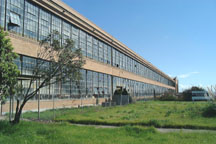The group selected to turn Richmondís old Ford assembly plant into a $55 million waterfront center for creative and performing arts says it will bring ferry service back to Richmond.

The old Ford Motor plant is an Art Deco architectural masterpiece certain to become the focus of an exciting live/work community linked to San Francisco and the Bay region by ferry service. Expensive improvements to the neglected structure will have to come first however.
By Jim Mallory
Published: August, 2002
The group selected to turn Richmond’s old Ford assembly plant into a $55 million waterfront center for creative and performing arts says it will bring ferry service back to Richmond.
"We know we need a ferry boat and we put our money where our mouth is," said Assembly Plant Partners Project Director Ethan Silva. He said the group developing the waterside former automobile plant will either buy a boat or provide the city with the necessary funds to purchase one by the time the proposed giant workshop for film editing, set design, and special effects opens. That opening is expected before the end of 2005.
The Richmond City Council recently entered into a one-year "right to negotiate" agreement with Assembly Plant Partners. Both sides hope the negotiations will lead to a Memorandum of Understanding that will include financial details. Once the MOU is signed, the next step will be to complete a development agreement, said Richmond Acting Redevelopment Director Tom Mitchell.
Silva said his group’s plan will give Richmond "a facility that is dedicated to the creation of items for the entertainment industry and a facility for artists to work in." Silva is a well-known set designer who also created Pac Bell Park’s giant coke bottle. Another partner in the venture is Gerard Howland, a designer whose firm has done work for Disney and the 1996 Olympics.
If the project flies, it could be a huge economic boon to Richmond, which heavily promotes its 38 miles of shoreline as "the most shoreline of any city on the bay" and one of its biggest assets. However, the city and the developers still face a number of regulatory hurdles before the deal is finalized. "We are subject to outside regulatory bodies including the National Park Service, BCDC, and other folks who are outside our jurisdiction. We also have the normal city planning process to go through," said Mitchell.
The ambitious plan calls for a shop to build stage scenery, special effects labs and advanced computer graphics workshops, post-production facilities, and artist’s studios. "The building lends itself to artistic work. It has excellent light," said Silva.
A 15,000 square foot, 500-seat theatre to host theatre productions and concerts is also included. "When it’s done it will be an exciting place for people to come," said Silva.
Also proposed as part of the development are a National Park Service interactive exhibit and the Rosie the Riveter WWII Home Front National Historical Park visitor center. The Rosie the Riveter memorial, located in nearby Marina Bay Park, was designed by the artist team of Susan Schwartzenberg and landscape architect Cheryl Barton. The memorial graphically illustrates the scale of the liberty ships built in Richmond during WWII, while using text and photographs to document the importance of the contribution women made to Home Front labor across the nation. The memorial is located just a few blocks northeast of the Ford plant.
Silva said there would also be a museum, a café, and an art gallery where artists can sell their works. "Hopefully, it will become a cultural Mecca for the entire bay area," said Mitchell. Plans also include a landscaped atrium running the length of the building where visitors could stroll and watch artist at work.
The $55 development could bring almost $1 million a year in sales tax and other revenues to the city’s coffers, according to Mitchell. Silva said funding will come from several sources, including approximately $15.5 million from the Federal Emergency Management Agency, up to $29 million from the city of Richmond, and the remainder from private investors. The FEMA funds are available because the building, which is on the National Register of Historic Places, was seriously damaged in the 1989 Loma Prieta earthquake.
Silva and Mitchell are optimistic that construction on the 500,000 square foot brick building, which is located on the San Francisco Bay at the foot of Marina Way South a short drive off I-580, could start before the end of the year. If Assembly Plant Partners acquires a ferry, that could attract patrons from the San Francisco side of the bay, including residents and tourists. The ferry landing used by the ill-fated Red & White Ferries service from Richmond to San Francisco is just a 50-yard stroll from the Ford plant. Red & White operated a commuter ferry service between Richmond and San Francisco for about a year, but pulled the plug on that run in late 2000 when ridership didn’t meet expectations.
The Ford plant was completed in 1929 and turned out Ford automobiles from 1931 until the start of World War II, when production was switched to tanks and trucks. The first vehicle, a truck, that rolled off the assembly line was used by the city for many years. It was restored recently with the help of Ford Motor Co. and is now at the Richmond Museum.
The city of Richmond purchased the plant in 1979. Last year, a $130 million development plan put forth by Forest City Residential West that would have converted the building into retail spaces, offices, and live-work lofts died after two years of negotiations.

The old Ford Motor plant is an Art Deco architectural masterpiece certain to become the focus of an exciting live/work community linked to San Francisco and the Bay region by ferry service. Expensive improvements to the neglected structure will have to come first however.

The old Ford Motore plant in Richmond looking east; note the currently unused ferry landing.

